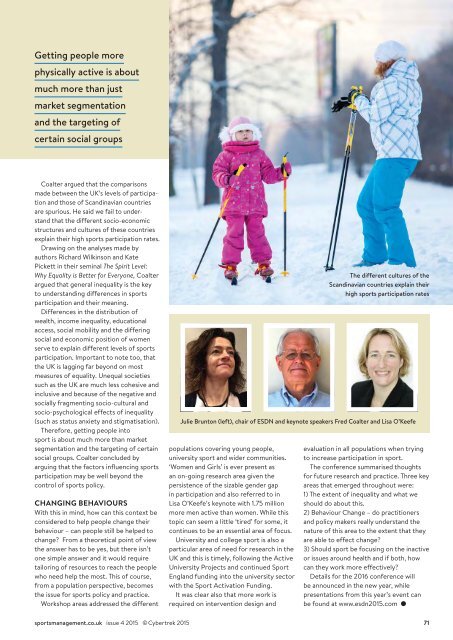EDDIE IZZARD
SM_issue4_2015
SM_issue4_2015
Create successful ePaper yourself
Turn your PDF publications into a flip-book with our unique Google optimized e-Paper software.
Getting people more<br />
physically active is about<br />
much more than just<br />
market segmentation<br />
and the targeting of<br />
certain social groups<br />
Coalter argued that the comparisons<br />
made between the UK’s levels of participation<br />
and those of Scandinavian countries<br />
are spurious. He said we fail to understand<br />
that the different socio-economic<br />
structures and cultures of these countries<br />
explain their high sports participation rates.<br />
Drawing on the analyses made by<br />
authors Richard Wilkinson and Kate<br />
Pickett in their seminal The Spirit Level:<br />
Why Equality is Better for Everyone, Coalter<br />
argued that general inequality is the key<br />
to understanding differences in sports<br />
participation and their meaning.<br />
Differences in the distribution of<br />
wealth, income inequality, educational<br />
access, social mobility and the differing<br />
social and economic position of women<br />
serve to explain different levels of sports<br />
participation. Important to note too, that<br />
the UK is lagging far beyond on most<br />
measures of equality. Unequal societies<br />
such as the UK are much less cohesive and<br />
inclusive and because of the negative and<br />
socially fragmenting socio-cultural and<br />
socio-psychological effects of inequality<br />
(such as status anxiety and stigmatisation).<br />
Therefore, getting people into<br />
sport is about much more than market<br />
segmentation and the targeting of certain<br />
social groups. Coalter concluded by<br />
arguing that the factors influencing sports<br />
participation may be well beyond the<br />
control of sports policy.<br />
CHANGING BEHAVIOURS<br />
With this in mind, how can this context be<br />
considered to help people change their<br />
behaviour – can people still be helped to<br />
change? From a theoretical point of view<br />
the answer has to be yes, but there isn’t<br />
one simple answer and it would require<br />
tailoring of resources to reach the people<br />
who need help the most. This of course,<br />
from a population perspective, becomes<br />
the issue for sports policy and practice.<br />
Workshop areas addressed the different<br />
populations covering young people,<br />
university sport and wider communities.<br />
‘Women and Girls’ is ever present as<br />
an on-going research area given the<br />
persistence of the sizable gender gap<br />
in participation and also referred to in<br />
Lisa O’Keefe’s keynote with 1.75 million<br />
more men active than women. While this<br />
topic can seem a little ‘tired’ for some, it<br />
continues to be an essential area of focus.<br />
University and college sport is also a<br />
particular area of need for research in the<br />
UK and this is timely, following the Active<br />
University Projects and continued Sport<br />
England funding into the university sector<br />
with the Sport Activation Funding.<br />
It was clear also that more work is<br />
required on intervention design and<br />
The different cultures of the<br />
Scandinavian countries explain their<br />
high sports participation rates<br />
Julie Brunton (left), chair of ESDN and keynote speakers Fred Coalter and Lisa O’Keefe<br />
evaluation in all populations when trying<br />
to increase participation in sport.<br />
The conference summarised thoughts<br />
for future research and practice. Three key<br />
areas that emerged throughout were:<br />
1) The extent of inequality and what we<br />
should do about this.<br />
2) Behaviour Change – do practitioners<br />
and policy makers really understand the<br />
nature of this area to the extent that they<br />
are able to effect change?<br />
3) Should sport be focusing on the inactive<br />
or issues around health and if both, how<br />
can they work more effectively?<br />
Details for the 2016 conference will<br />
be announced in the new year, while<br />
presentations from this year’s event can<br />
be found at www.esdn2015.com <br />
sportsmanagement.co.uk issue 4 2015 © Cybertrek 2015 71


